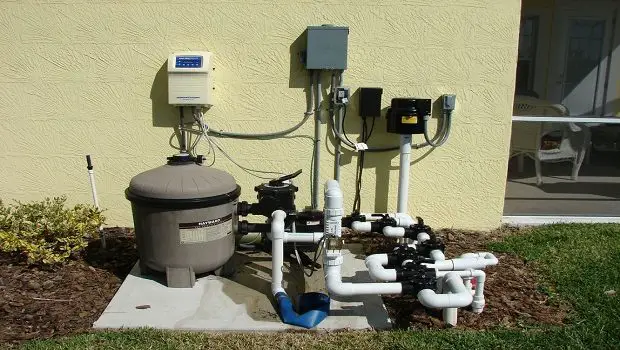How to Select The Best Pool Filter: Sand, Cartridge or DE?
DISCLOSURE: As an Amazon Associate, I earn from qualifying purchases.
Pool filters are as crucial to your swimming pool as your kidneys are to your body.
I know that seems kind of gross, but it is true.
After your chlorine kills bacteria and other germs, your pool filter eliminates them from your water.
Without a properly working filter, your pool water would become cloudy and filled with dead organic debris.
Not exactly fun for swimming!
So how do you decide on the best filter for your pool?
This question should never be about which pool filter is the cheapest, though the price is undoubtedly a factor.
First and foremost, you need a pool filter that will catch dirt, is simple to maintain and clean, and lasts more than just a couple of seasons.
To make the best choice for your pool, you first need to understand all of your options.
Three Types of Pool Filters
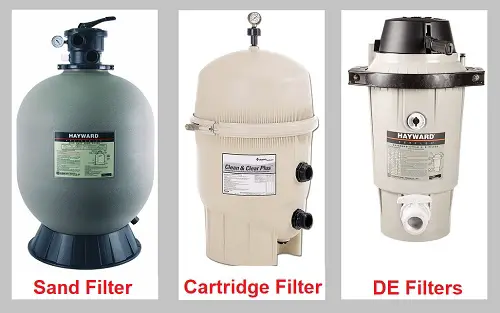
The first step to pick the best filter is knowing what your options are.
You have three kinds of filters to choose from: cartridge, sand, and diatomaceous earth or DE.
Price, filtration rates, and replacement frequency differ by type.
If you are thinking about how to clean a pool filter, that will depend on the kind you select.
However, before you can accurately compare pool filter kinds, how well they function, and how much work they need to maintain, you need to know your microns.
What the Heck is a Micron?
Pool filters are designed according to the size of contaminants they’re able to remove in microns, the acronym for micrometer, which is one-millionth of a meter.
Having difficulty picturing just how small that is?
A single strand of human hair is around 50 microns or about .05 millimeters in diameter.
Some germs measures about 2 microns, or about .002 millimeters in diameter.
Whether they are killed by chlorine or not, bacteria and other contaminants can be filtered out when the filter media, which genuinely does the filtering—is fine enough to collect tiny particles.
Sand Filters
If you’re on a budget and want to spend minimal time on maintenance, a sand filter is the best choice for you. It’s also great for big pools as it won’t clog as quickly as other filters.
Your pool pump draws water in from the skimmers, then drives it through a large filtration tank full of sand. The conventional media used within the tank is #20 silica sand. It collects particles that measure 20 microns and more.
Each bit of sand is, for lack of a better word, prickly. You would see it if you could look at it under a microscope that has lots of small edges all around it, and that’s how it grabs debris and contaminants which pass through the filter.
As time passes, and more water runs through the filter, those rough edges are gradually worn down by erosion, finally becoming smooth surfaces that aren’t able to capture anything.
While the particles trapped within the sand will build up over the life of the filter, this can help trap tinier particles, even as the sand itself starts to smooth out. Finally, it will prevent proper water flow through the filter, decreasing the filter’s efficiency.
A pressure gauge on the filter side will alert you to increasing internal pressure–a signal it is time to backwash the filter. This simple cleaning method the filter reverses the water flow, flushing all the debris to waste.
As the silica captures particles of 20 microns or larger, you have to remain on top of your pool water chemistry. When there’s not sufficient sanitizer on your pool to kill these little, 2-micron bacteria, a sand filter is not likely to catch them, and they will be floating around in your swimming pool with you.
Sand Alternatives
However, #20 Silica is the conventional media in sand filters; it is possible to marginally improve filtration performance by replacing the sand or adding DE powder after backwashing.
You can also completely replace the silica with one of two alternatives.
ZeoSand: This is made from a mineral known as zeolite. It’s crystal-like pattern generally traps little contaminants than silica. This increases water clarity and needs less routine backwashing. ZeoSand remains about five years, so its lifespan is the same as silica.
Filter Glass: This is nicely crushed, recycled glass. Don’t be concerned about cuts—it’s soft to the touch. It’s a negative charge, which pulls positively charged atoms, such as manganese and iron. You can use around 20% less filter glass than you’d silica while filtering debris as small as 5 microns. Additionally, it lasts up to three times longer than pool sand.
Sand Filter Pros:
- Lower cost
- Easier maintenance
- Sand lasts five to seven years before requiring to be changed
- Filtration efficiency can be enhanced with additives alternative media
Sand Filter Cons:
- 20-micron filtration is less efficient than the three kinds
- Backwashing and rinsing wastewater
- Building pressure decreases filter efficacy
Cartridge Filters
Though they’re typically somewhat more costly than sand filters, cartridge filters are simple to maintain, and therefore are more efficient as long as you do not have a big pool.
Inside a tank marginally smaller than their sand cousins is a plastic cylinder enclosed by pleated polyester filter media and capped on each end. Water moves to the tank and through the pleats. Debris is as small as 10 microns are captured in the filter, then water heads back to the pool.
Cartridges are affordable and energy-efficient. As the filter collects contaminants, it’ll require cleaning. Rather than backwashing, you will just remove the cartridge from the tank, and then spray it with a hose to remove dirt.
Occasionally, you will want to spray it down with a filter cleaner, and regularly, soak it in a chemical filter cleaning solution or diluted muriatic acid. While this is somewhat more physical work for you than backwashing, it wastes less water.
Cartridge Filter Pros:
- Works well at low speeds, such as with variable-speed pumps
- Filters contaminants as small as 10 microns
- No backwashing; less water waste
Cartridge Filter Cons:
- More work than sand filters
- Lasts only 2-3 years
- Deep cleaning needed 1 to 2 times per year.
Diatomaceous Earth (DE) Filters
The most pricey, maintenance-intensive option happens to filter the smallest particles of three kinds of filters: 5 microns.
DE filter tanks contain grids or “fingers” covered in the crisp, white powder.
The powder is made of the crushed fossilized leftovers of small aquatic organisms known as diatoms.
Though DE and sand pool filters are somewhat distinct, the fossils in DE will also be composed of silica.
Silica is also used in pest control products, makeup, and even toothpaste, but DE silica made for pool filters is heat-treated to serve as a filtration media.
So don’t try to sprinkle that Rid-O-Pest powder in your pool filter when you run out of DE!
Bump-Cleaning (Backwash)
Same as sand filters, a pressure gauge on the tank will notify you when it is time to wash your DE filter.
Typically, DE filters are backwashed like sand filters.
Some brands feature a bulge handle, which lets you knock used DE silica off the grids when cleaning.
Whether you backwash or bump clean the filter, you will have to add more DE powder after every cleaning.
It can be hard to determine precisely how much to add, so it is particularly essential to disassemble and clean the filter using hands at least once each year.
How to Add New DE To Your Filter
After you’ve cleaned your filter, instead of adding DE powder directly to the grids, you will get far better coverage if you add it through the pool skimmer.
- Mix the DE with sufficient water to make a slurry, which will seem like a thin, creamy alternative.
- Make sure the pool pump is running.
- Gently pour the solution directly into the skimmer.
As the DE passes through the filter, it will evenly distribute over the grids.
You’ll have to wait a while before swimming to provide the mixture time to completely integrate with the filter, so you may wanna do this in the evening, and then let your pump run overnight.
Illegal Backwashing
Some towns and cities appreciate backwashing as much as parents of small kids do.
Yours may have laws defining how to legally dispose of used DE.
When it’s rinsed from the grids, DE powder can build up over time, developing a concrete-like residue that can suffocate fish eggs or clog storm drains.
Generally, you’ll be allowed to empty old DE into a disposable container and place it in the trash.
Check with your regional authority for specifics to ensure you don’t end up with a fine, and more importantly, don’t damage the environment.
Cancer Risk with DE Filters
Though DE is a known carcinogen, it’s only been shown to cause cancer in mice if inhaled long term.
So: Safety first!
Avoid accidental inhalation by wearing a chemical mask when you manage DE powder.
Additionally, keep pets and children away from the region when working with DE powder, and from the area where it’s stored.
Quickly clean up any spilled powder.
D.E. Filter Pros:
- Filters contaminants as small as 5 microns
- DE Powder can be added inserted via the pool skimmer
- No caustic chemicals are needed for cleaning
D.E. Filter Cons:
- Highest price filter
- Annual cleaning is a lot of work
- Grids require replacement every 2-3 years
- Difficult to find for above ground pools
- Backwashing may be limited by the area
- DE Powder may be harmful if inhaled
Size Matters
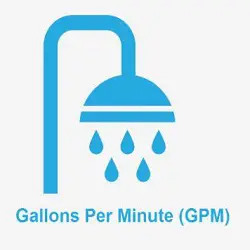
A pool pump and filter go together. The filter can not operate without the pump to move water through it. Plus, neither will work properly if the pump isn’t the correct size for your pool.
Before you settle on a pool filter, be sure you have the ideal dimensions pool pump.
Filter Size
Filters are measured in gallons per minute (GPM) per square foot.
The filter flow rate has to be rated higher at the same GPM as your pump, or higher.
With pool filters, it’s better to err on the larger size to handle the power of your pump.
A helpful rule of thumb is to pick a filter with at least 1 square foot per 10,000 gallons pool capacity.
Bargain shoppers beware. It’s great to save money when you can.
However, brands come and go, leaving you looking for replacement products from defunct companies down the road.
Purchasing a pool filter from a trusted manufacturer can save you headaches and dollars in the long run.
How to Troubleshoot a Pool Filter
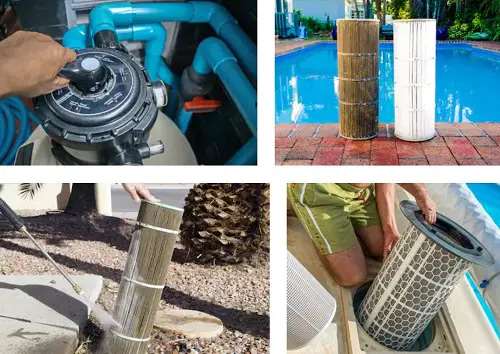
As it plays a significant role in keeping your pool clean, you must maintain your pool filter in a good state.
Filters run into a few common issues, and understanding how to recognize them can help you troubleshoot and repair them.
Leaks
Do you see or hear water leaking in your filter?
Perhaps you have seen a small puddle building below it?
If so, your pool filter may have a leak.
A leak in your filter will not cause a significant drop in the pool’s water, but it is still essential to recognize and fix it before it worsens.
First, try to find out the source of the leak. Check the tank of the filter for any holes. If you find one, you may be able to patch it. Though be ready to substitute the tank as a patch likely won’t hold up for very long.
If you have a split-tank filter, look at the belly for leaks. Take out the band and inspect the O-ring for debris or wear and tear. You will want to replace it if it’s worn out. Don’t forget to add pool gasket lubricant for sealing, and to keep the ring hydrated, which will help it last longer.
Cycle Problems
If your filter appears to be running in short spans, and see this happening even when the pool is not being used, the filter might have a flow rate issue.
The likely issue is that the flow rate is too high, so your pool pump might be too strong for your filter. It could also indicate your filter isn’t big sufficient for your pool.
If your filter is the ideal size, you might have to backwash the filter for a more extended period. When backwashing, continue the process until the water in the sight glass is clear. This could take a few minutes.
The filter is maybe operating in shorter cycles since algae or other debris is jamming it. Clean the pool filter thoroughly, and think to replace it if it looks worn out.
Filter Material In The Pool
It’s not uncommon to find some filter material in the pool after backwashing, no matter what type of filter. However, if you start noticing it when you have not just backwashed, you might have a problem.
The first thing to see is the bolts holding the filter in place. If they are loose, it might allow particles to escape into the pool. If they’re not, look for other reasons.
If you have the filter lateral, a sand filter, or a standpipe may be damaged. If it is, you’ll have to replace it.
If you have a DE filter, there might be a tear in the grid’s fabric or just a crack at the grid manifold. Again, if this is the issue, you will want to replace the manifold.
Water Pressure Problems
Checking the pressure gauge should be a part of your pool maintenance. Difficulties with water pressure can affect your pool filter’s performance.
If the pressure is too low, there might be a blockage in the system somewhere before the filter. There may be a blockage at any stage after the filter if the pressure is too high.
Thoroughly examine the filter system to find out if it is clogged, and if necessary, clean it. If you do not find any clogs, and the filter is clean, see the return valve to ensure it’s completely open, and then double-check the lines to check if you can find a clog.
Best Sand Filters
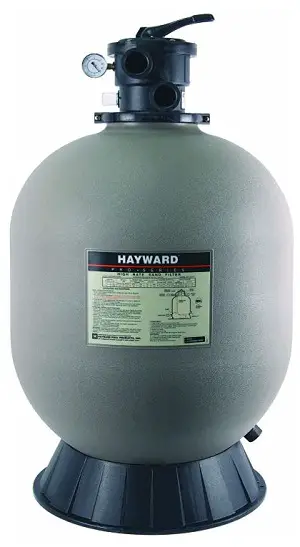
If you’re on the lookout for low-maintenance, low-cost filtration that won’t clog up suddenly, the modals given below are just the best.
Hayward S244T ProSeries Sand Filter (For Inground Pools)
Featuring a corrosion-proof, a weatherproof tank, the S244T ProSeries, is designed to last. It comes in 3 sizes and includes a multi-port valve.
You can get units with side mounts if required. You need to backwash it every two or three months, depending on how frequently you use your pool.
Pentair Triton II Sand Filter Without Valve (For Inground Pools)
Built with ease of use in mind, the Pentair Triton II is the picture of simplicity. The pressure gauge is appropriately located and easy to read. Its swing-away diffuser provides you quick access to the sand. And the combination water/sand drain makes winterizing a snap.
Intex Krystal Clear Sand Filter Vacuum (For Above Ground Pools)
If you have An Intex pool, it is good to get a sand filter designed for it. The Intex Krystal Clear includes a 24-hour timer so that you can automate filter cycles. The six-function valve quickly switches between filter, rinse, recirculate, backwash, drain, and close.
It is easy to break down and store this filter through the winter. Plus, you need to replace sand every five years or so.
Best Cartridge Filters
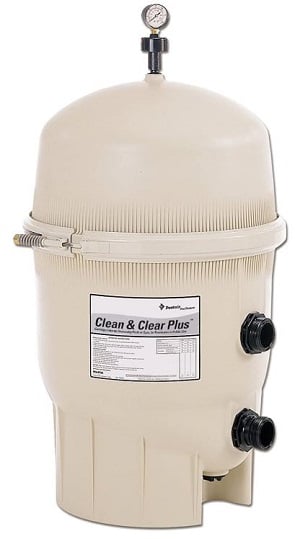
Want a finer filter press than sand, without the cost or maintenance that is labor-intensive? Four cartridge versions do the job.
Pentair 160340 Clean & Clear Plus Cartridge Pool Filter (For Inground Pools)
Built with the largest filter surface area to clean your water quickly and efficiently than other filters, the Pentair Clean & Clear Plus includes an effective filter area of 320 square feet. Internal and manual air relief makes managing good water pressure easy. It filters 120 GPM inside a heavy, injection-molded tank.
Hayward C2251540LSS Micro StarClear Filter (For Above Ground Pools)
Micro StarClear is among the trusted name in the pool industry. This small Hayward filter is simply right for above ground pools under 15,000 gallons. It gives easy access to the cartridge for changes, and you can turn the head, so the manual air relief valve and pressure gauge are right where you need them.
Intex 28633EG Krystal Clear Cartridge Filter Vacuum (For Above Ground Pools)
If you own an Intex and looking for a cartridge filter, this is the one for you. Unlike other options, this filter has disposable cartridges. Maintenance is as simple as rotating the handy flush valve and adding a new cartridge.
When the season ends, disassemble and store it with your pool. If the weather is moderate, its double-walled structure means you can just leave it up with no worries.
Best DE Filters
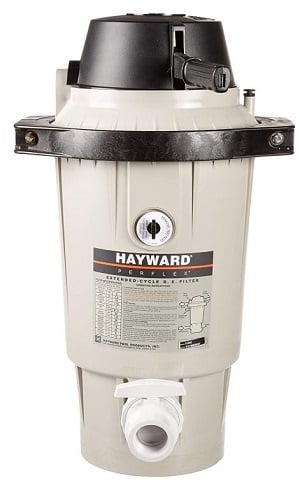
For just a bit more money and upkeep, you can enjoy the best filtration available by selecting a DE filter.
Pentair 188592 Quad Cartridge Style DE Pool Filter (For Inground Pools)
Designed with easily detachable cartridges, the Pentair Quad makes maintenance a bit easier. It’s four, large-capacity cartridges provide plenty of surface area so that your pump uses less electricity to get the water as clean as other DE filters.
The increased surface area also implies it takes much time to clog, so you can clean it less frequently. It’s all contained inside a durable, fiberglass-reinforced polypropylene tank.
Hayward EC40AC Perflex Extended-Cycle D.E. Pool Filter (For Above Ground Pools)
If you want low maintenance and serious cleaning, Hayward Perflex Extended-Cycle is the perfect option.
With a cooling bump mechanism which allows the D.E. Flex-Tubes to clean themselves, this modal means minimal cleaning time.
It is designed to minimize resistance, so it can maximize efficiency at a lower horsepower.
The Best Filter For You…?
You can spend less money on a cheaper filter and spend more time cleaning and changing filters, or you can spend a little more initially for better filtering to save the cost of more work and time.
The filter you buy really depends on you – what’s best for your time and your budget.
No matter what type of pool filter you choose, keep in mind that keeping your water chemistry balanced is more than half the battle in having a clean pool.
Stay on top of maintenance and cleaning, and your filter and your pool will last you for many years to come.

